Physical Abilities Test (PAT)
Physical ability testing for public safety positions.
Physical
Abilities
Test
PAT
Physical abilities are an important part of most law enforcement and fire service positions. Firefighters must be able to climb stairs, carry heavy equipment and drag unconscious victims. Police must be able to chase down and physically control suspects. Physical Ability Testing is critical for your successful public safety agency hiring. IOS follows best practice methods when developing and validating PATs, and uses established and well-tested measures to assess candidates’ physical ability. However, each organization is unique and each administration site is different. IOS will work with you to establish and validate specific measures that are right for your agency and will ensure that the Physical Abilities Test is properly constructed for your specific administration site.

Methods for Physical Abilities Test
Job Simulation Method
This model ensures each candidate meets the physical requirements for firefighter or police officer positions. Job simulations assess a candidate’s physical ability through a series of high-fidelity physical simulations, or simulations that closely mirror the exact physical activities that might be encountered on the job. By assessing candidates’ ability to perform physical tasks that closely mirror the tasks of the actual job, the job simulation is able to identify candidates who meet the physical requirements for firefighter or police officer positions. Job simulation physical ability testing typically follows a single hurdle approach, where an overall cut-off time is established – i.e., individual events are not timed. Job simulation physical ability testing should never be gender or age-normed for the cut-off point as this is logically inconsistent with this type of PAT.
IOS specializes in the development of Job Simulation Physical Ability Tests. There are two main components to this model – linking test activities to actual job content and determining an appropriate timed cut-off score. Both of these components are essential to ensure that any job simulation is valid and appropriate for use to select qualified applicants.
Fitness Based Method
This model ensures each candidate meets the physical requirements for firefighter and police officer positions. A fitness-based PAT operates on the premise that a physically-fit candidate is more likely to competently perform physical job tasks. Fitness-based physical ability testing typically has multiple hurdles where individuals must successfully complete each exercise/activity in a given time. Some fitness-based models are normed based on gender and age, though this is legally questionable based on many court case findings.
Most physical job tasks of firefighters and police officers are time-sensitive so it is essential that the test performance occurs within an acceptable time period. One of IOS’ core services in this area is to work with your organization to establish cut-off scores that accurately identify minimum competency. IOS does not espouse norm-based cut-off scores as it is legally questionable to do so.
How Physical Abilities Test Overall Results Are Used
Job Simulations
Job simulation physical abilities tests typically follow a single hurdle approach, where an overall cut-off time is established—i.e., individual events are not timed. In a job simulation, there may be multiple distinct events that are separate from the overall obstacle course simulation—i.e., gun dry fire simulation, aerial ladder climbs. Final results are typically used in a pass/fail manner.
Fitness Based
Fitness-based physical abilities tests typically have multiple hurdles where individuals must successfully complete each exercise/activity in a given time. Failure in any event would lead to the failure on the overall Physical Abilities Test. Some fitness-based PATs may have a point-based system, which requires obtaining enough points to pass—but this is less common.
PAT Support Materials, Training Guides and Videos
In order to enhance candidates’ overall performance on physical ability testing, IOS recommends developing a training guide or video for candidates. Some agencies have hosted live training events for candidates to practice prior to the live examination.
Firefighter PAT
IOS has partnered with Firesled Fitness to build a better firefighter physical ability test. The Fireground Physical Ability Test (FPAT) is a job-simulation test that assesses the most challenging physical abilities related to the firefighter job. The timed series of simulations mimic critical engine and ladder tasks, which include:
• Carrying fireground equipment
• Forcible entry using both a right-handed and left-handed orientation
• Carrying a ladder
• Climbing a ladder
• Advancing a charged hoseline
• Crawling
• Feeding a charged hoseline
• Breaching and puling ceiling
• Dragging a victim
• Cardio-vascular endurance is indirectly assessed throughout the entirety of the test
The FPAT was developed to address deficiencies in other available physical ability tests. The FPAT has these unique advantages:
• Assesses Applicants and/or Incumbents: Firefighters should be held to a constant, minimally qualified standard of performance throughout their career. A job simulation physical ability test, when well-designed and validated, is the right tool to assess applicants and incumbents. The FPAT was built for both purposes. The same minimally-qualified standard can be applied in both situations. In addition, IOS will provide normative data to create “incentive” levels of performance beyond minimal qualifications for those agencies that implement an incentive-based incumbent screening process.
• Cost Effective Equipment Designed by Firefighters: The FPAT, and associated Firesled equipment, was designed by firefighters for firefighters. Industrial psychologists took care of the validation of the test, but the components and standards were based on the input of firefighters to ensure that the FPAT assesses the most challenging aspects of the job in a fair and consistent manner. Firesled Fitness specializes in firefighter wellness and fitness and manufactures its equipment in the United States.
• Adaptable and Easy-to-set-up Course: The FPAT is a modular test that can be set up quickly and easily, was designed to fit within a standard fire apparatus bay, and can be adapted to many other sites.
• Criterion-related Validation Evidence: The FPAT was rigorously designed and validated to ensure its defensibility. It is supported by criterion-related validation evidence, which demonstrates that the test predicts important factors of job performance.
• Locally Customizable: Fire department operate in a number of different contexts; therefore, the FPAT developers designed a local validation process that considers the appropriateness of the test components, specifications and cut-off score. These features can be tailored as needed to ensure that the FPAT reflects the job in each locale.
The FPAT is a unique test that will help you find physically qualified firefighters.
Firefighter Physical Abilities Testing Process
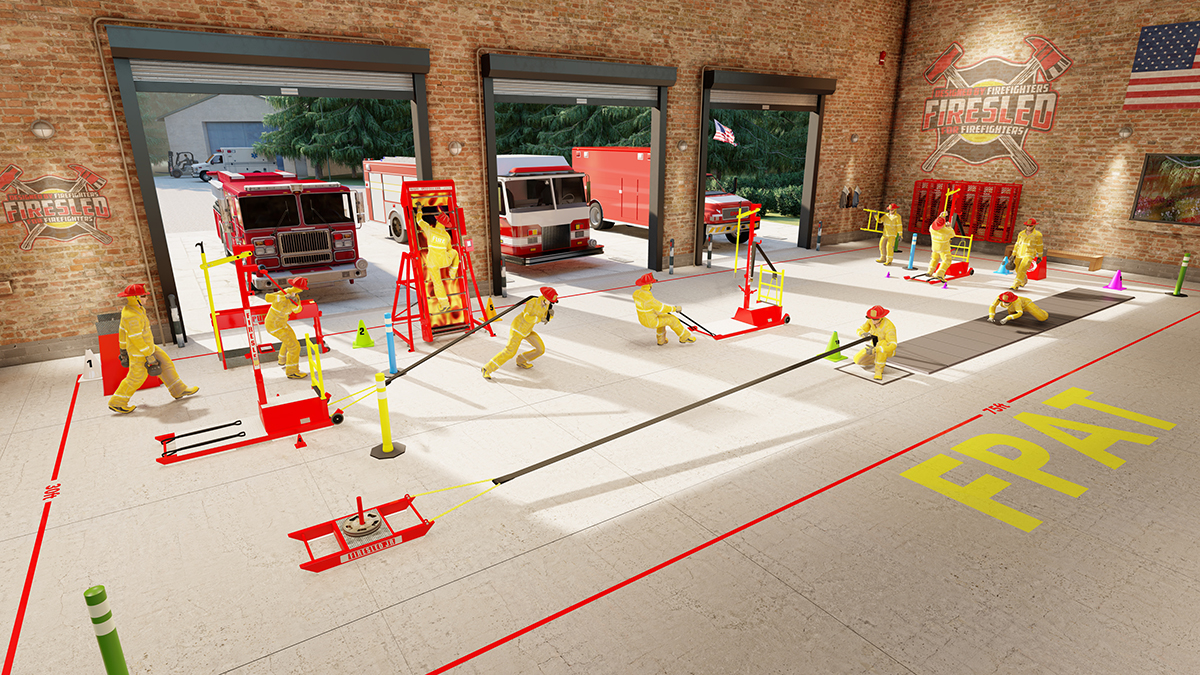
Event 1
Title: Equipment Carry
Description of Event: Simulates carrying a chainsaw and K12 saw with a 20 and 25 pound kettlebell. The candidate will lift both kettlebells off the 3 foot platform and walk 115 feet returning the kettlebells to the platform.
Event 2
Title: Forcible Entry
Description of Event: Candidate removes dead blow hammer and strikes the Punisher box until the box travels to the opposite end, remaining on the same side of the Punisher. They then strike the box until candidate is back at the original end.
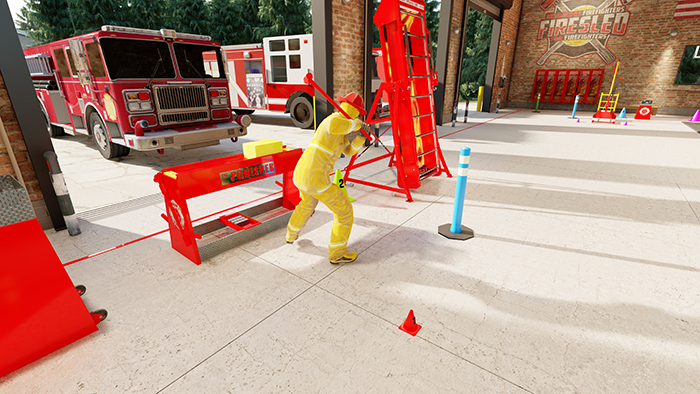
Event 3
Title: Rehab Walk
Description of Event: 100′ rehab walk to allow candidate to lower heart rate.
Event 4
Title: Ladder Carry
Description of Event: Candidate will lift the 65 pound ladder prop from the Firesled and carry on shoulder or extended arm carry for 115′ and place back on the Firesled.
Event 5
Title: Ladder Climb
Description of Event: Candidate will climb 50′ on the Firesled Edition Laddermill. The speed will be determined by the candidate.
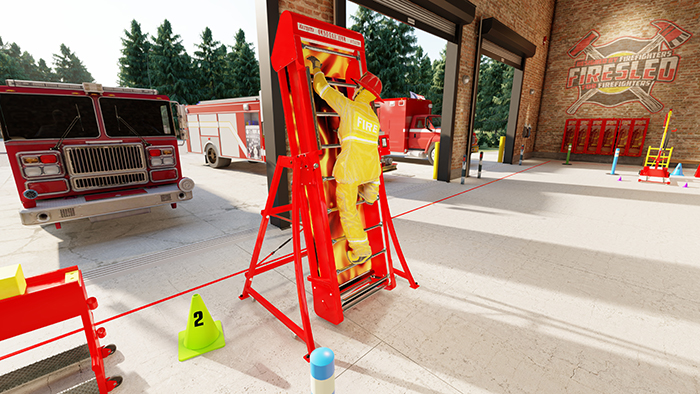
Event 6
Title: Rehab Walk
Description of Event: 140′ rehab walk to allow the candidate to lower heart rate.
Event 7
Title: Advancing a Charged Hoseline
Description of Event: Candidate simulates advancing a charged 1 3/4″ hoseline by removing the hose from the Firesled, placing it over their shoulder and moving forward 50′.
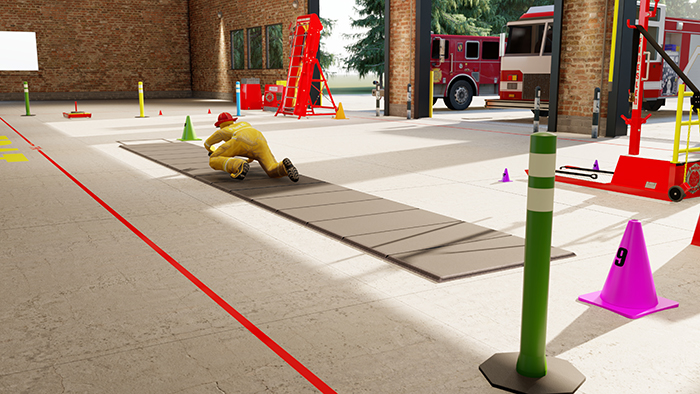
Event 8
Title: Equipment Carry
Description of Event: Candidate simulates carrying a high rise pack or spreaders by lifting a 45 pound kettlebell from a 2′ platform, carry 100′ and returning it to the platform.
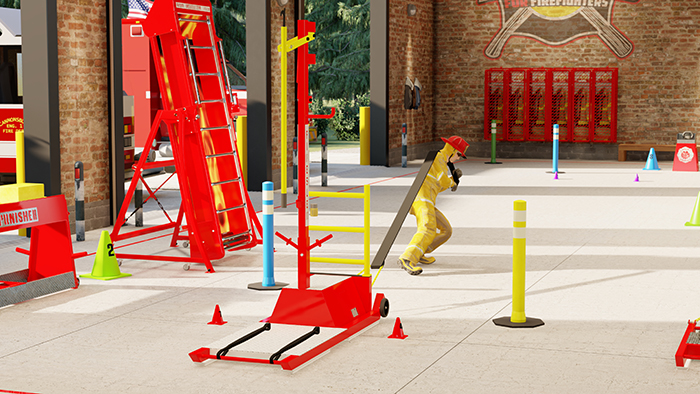
Event 9
Title: Crawl
Description of Event: Candidate crawls 25′ on an anti-fatigue mat.
Event 10
Title: Hose Feed
Description of Event: Candidate kneels in a 3′ x 3′ box and picks up the simulated 1 3/4″ charged hoseline and pulls the Firesled junior to them 20′ simulating feeding a line into a structure.
Event 11
Title: Rehab Walk
Description of Event: Candidate walks 70′ to lower heartrate.
Event 12
Title: Ceiling Breach
Description of Event: Candidate simulates breaching a ceiling by stepping on the Firesled platform, grabbing the pike pole and performing 20 ceiling breach repetitions. One stroke all the way up and all the way down is one repetition.
Event 13
Title: Victim Rescue
Description of Event: Candidate simulates removing a victim from a hazardous environment by grabbing a strap in each hand located in the rear of the Firesled, leaning and moving backward for 50′.
For further information concerning the FPAT course, please visit our partner’s website.
Police Officer Physical Abilities Testing Process and Events
Event 1
Title: Car Exit
Equipment: Police squad car or equivalent
Description of Event: Candidates will be seated in the driver’s side of a squad car with a fastened seatbelt. Candidates will be wearing a 10-pound weighted vest that will remain on throughout the duration of the course. Timing will begin once the candidate opens the squad car door. Candidates should unbuckle their seatbelts before exiting the vehicle. Upon exiting, candidates must close the squad car door.
Purpose: Ensures candidates can quickly and safely exit the vehicle with simulated weighted vest.
Event 2
Title: Obstacle Weave
Equipment: 5 traffic cones
Description of Event: After exiting the vehicle, candidates will be required to weave through five traffic cones. There will be tape on the ground curving around the cones that will guide candidates through the weave pattern.
Purpose: Simulates pursuit of a suspect through crowded/obstructed streets, alleyways or shopping centers.
Event 3
Title: Duck Under
Equipment: 2 barricade traffic horses
Description of Event: Candidates will encounter two barricades (i.e., traffic horses) under which they must duck, crawl or slide. The objective of this component is for candidates to get themselves under the obstacles without displacing them or knocking them over.
Purpose: Ensures candidates can crawl under obstacles they may encounter in pursuit of a suspect.
Event 4
Title: Stair Climb and Descent
Equipment: Stairs
Description of Event: Candidates will climb X flights of stairs. During this process, candidates should exercise caution when ascending and descending the staircases. Hitting every stair is recommended as a safety precaution, and no jumping should be allowed.
Event 5
Title: Wooden Fence Climb
Equipment: Wooden fence of X height (6 foot is typical).
Description of Event: Candidates are required to scale the 6-foot wooden fence. There are two footholds located on the wooden fence that candidates are allowed to use to assist in climbing the fence. Once the candidate has reached the top of the fence, he/she should carefully lower his/her body over the other side of the fence. Candidates should not stand on top of the fence and jump down. This could result in an injury that disqualifies the candidate from the test (and further consideration).
Event 6
Title: Jump-overs
Equipment: Floor mats
Description of Event: Candidates will encounter two jump-over obstacles. Candidates are required to jump over the obstacles without coming into contact with them. Examples of obstacle dimensions: 10 inches high and 26 inches wide.
Event 7
Title: Chain-link Fence Climb
Equipment: Chain-link fence
Description of Event: Candidates are required to climb the 4-foot fence. Candidates are not allowed to swing their body around the fence when engaged in this obstacle component. That is, a candidate’s entire body must go over the fence.
Event 8
Title: Suspect Grapple
Equipment: Flyweight or cross-cable machine, punching bag.
Description of Event: This station will have a weighted punching bag hanging from a fitness machine. Candidates must grab the bag and then proceed to pull the bag downward to one of the targets located on the floor on either side of the bag. The bottom of the bag must be positioned on the target area. Candidates must then bring the bag upward in a controlled manner until the bag is fully retracted. Candidates must then lower the bag onto the opposite target area in the same fashion. The bag must be returned to its up position in a controlled manner before exiting the station. If at any time a candidate loses control of the bag, he/she will be instructed to begin this component over.
Event 9
Title: Dummy Drag
Equipment: 165-lbs. rescue randy, clothing, protective skid device, harness
Description of Event: The candidate will drag a dummy (165 lbs. dummy plus protective clothing—totaling no more than 185 lbs.) for a total of 50 feet (25 feet, around barrel, back 25 feet). The candidate may lift the dummy under the armpits or drag using harness handles.
Event 10
Title: Gun Dry Fire Simulation
Equipment: 165-lbs. mock gun, gun ring stand, gun ring (18-inch diameter hoop).
Description of Event: Once the candidate reaches the gun ring located at the front center of the stage, he/she will be required to dry fire using a mock gun while keeping his/her arm steady inside the ring. The candidate is required to cock the gun, insert his/her arm through the ring, fire the gun and withdraw his/her arm from the ring. This motion will be immediately repeated with the opposite hand. When firing the mock gun, the candidate’s arm cannot touch the sides of the ring at any point.
Success or Failure Criterion: Separate timed event from other events. If the candidate’s arm touches the ring, the candidate will have one more opportunity to test on this course component. If the candidate is unable to complete this component successfully in two attempts or less, the candidate will be disqualified from the Physical Abilities Test.
IOS PAT Key Points
A PAT will ensure that minimum fitness requirements are met without discrimination.
Valid and legally defensible: Physical ability tests are susceptible to legal scrutiny due to their tendency to produce disparate passing rates for males and females. On many tests, females tend to pass at rates lower than males and in many cases, the difference between these rates raises legal challenges for the testing agencies. The best defense against potential legal scrutiny for physical ability testing is to ensure that 1) the test was properly developed and validated locally, using best practices in Industrial/Organizational Psychology and 2) that the cut-off point is set at legally defensible and appropriate positions to differentiate between the qualified and unqualified applicant – i.e., identifying the minimally qualified cut-point. If both properties of physical ability testing are established, then the test will be a fair and appropriate selection tool.
On-site Administration: IOS will administer physical ability testing and/or develop training manuals to ensure that an agency’s proctors are sufficiently prepared and knowledgeable to administer their own testing.
Same day test result reporting: Since testing is conducted live with candidates, results are typically provided to candidates immediately after they complete their test. Official test scores are provided to agencies once all test takers have completed the Physical Abilities Test and scores have been aggregated into a final list. This typically takes a few days after the physical ability testing is completed.
Questions? Contact Us!

Telephone No.(888) 784-1290

